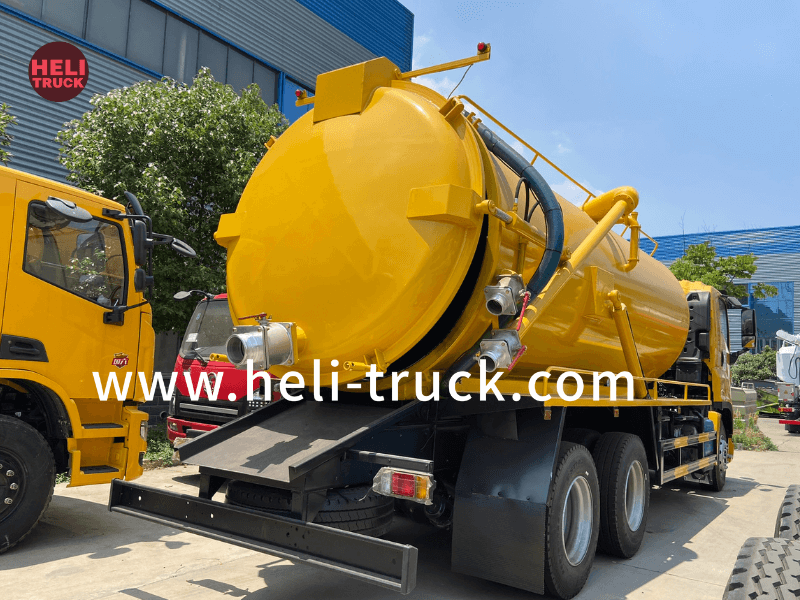The Ins and Outs of Vacuum Truck Operations
Introduction
Vacuum trucks play a crucial role in various industries, including construction, environmental cleanup, and waste management. These specialized vehicles are equipped with powerful vacuum systems that can efficiently remove liquids, sludge, solids, and other materials from a variety of environments. In this comprehensive guide, we will delve into the intricacies of vacuum truck operations, exploring their functions, applications, maintenance requirements, and safety considerations.
Overview of Vacuum Truck Operations
Vacuum trucks, also known as vac trucks or suction trucks, are versatile vehicles designed to extract and transport a wide range of materials. They are commonly used in situations where traditional methods of waste removal are impractical or inefficient. Vacuum trucks are equipped with a vacuum pump that creates a suction force, allowing them to effectively remove liquids, sludge, and debris from underground tanks, sewers, industrial facilities, and other confined spaces.
Key Components of a Vacuum Truck
A typical vacuum truck consists of several key components that work together to facilitate efficient operations:
1. Vacuum Pump: The heart of the vacuum truck, the vacuum pump generates the suction force necessary to extract materials from the target area. Vacuum pumps come in various types, including rotary vane, liquid ring, and positive displacement pumps.
2. Storage Tank: Vacuum trucks are equipped with a storage tank to contain the materials they collect. These tanks come in different sizes to accommodate varying capacities and can be made of steel, aluminum, or other materials depending on the specific application.
3. Hose and Suction Boom: Vacuum trucks are equipped with hoses and suction booms that allow operators to reach and extract materials from hard-to-reach areas. These components are essential for flexible and versatile operation.
4. Filtration System: To prevent debris and contaminants from entering the vacuum pump and causing damage, vacuum trucks are equipped with filtration systems that capture solid particles and allow only liquids and small particles to pass through.
Applications of Vacuum Trucks
Vacuum trucks are employed in a wide range of industries and applications, including:
1. Environmental Cleanup: Vacuum trucks are commonly used in environmental remediation projects to extract hazardous materials, contaminants, and spills from soil, water, and industrial sites.

2. Waste Management: Vacuum trucks play a vital role in waste management operations, including the collection and transportation of liquid waste, sludge, and sewage from residential, commercial, and industrial facilities.
3. Construction: Vacuum trucks are used in construction projects to remove debris, excavated materials, and other waste from construction sites. They are particularly useful in situations where access is limited or traditional methods are impractical.
4. Industrial Maintenance: Vacuum trucks are essential for maintaining industrial facilities by cleaning tanks, pipelines, and equipment, as well as handling spills and other emergencies.
Operating a Vacuum Truck Safely
Safety is paramount when operating a vacuum truck due to the potential hazards associated with handling hazardous materials, working in confined spaces, and operating heavy machinery. To ensure the safety of operators and bystanders, the following precautions should be taken:
1. https://www.heli-truck.com/foton-4ton-recovery-truck/ : Operators should undergo comprehensive training on the safe operation of vacuum trucks, including proper handling of materials, equipment maintenance, and emergency procedures.
2. Personal Protective Equipment (PPE): Operators should wear appropriate PPE, such as gloves, goggles, respirators, and protective clothing, to protect themselves from exposure to hazardous materials and prevent injuries.
3. Vehicle Inspection: Before each use, vacuum trucks should be inspected for any signs of damage, leaks, or malfunctions. Any issues should be addressed promptly to prevent accidents and ensure optimal performance.
4. Hazard Communication: Operators should be aware of the hazards associated with the materials they are handling and follow proper protocols for containment, disposal, and emergency response.
Maintenance and Care of Vacuum Trucks
Proper maintenance is essential for ensuring the longevity and efficiency of vacuum trucks. Regular maintenance tasks should include:
1. Routine Inspections: Regular inspections of the vacuum pump, hoses, filtration system, and storage tank should be conducted to identify any signs of wear, damage, or leaks. Any issues should be addressed promptly to prevent equipment failure.
2. Fluid Checks: Fluid levels, including hydraulic fluid, engine oil, and coolant, should be checked regularly and topped up as needed to prevent damage to vital components.
3. Filter Replacement: Filters should be replaced at regular intervals to maintain the efficiency of the filtration system and prevent debris from entering the vacuum pump.
4. Cleaning: Vacuum trucks should be cleaned regularly to remove debris, sludge, and contaminants that can build up and affect performance. This includes cleaning the storage tank, hoses, and suction boom.
Conclusion
Vacuum trucks are indispensable tools in various industries, providing efficient and effective solutions for waste removal, environmental cleanup, and industrial maintenance. By understanding the key components, applications, safety considerations, and maintenance requirements of vacuum truck operations, operators can ensure the safe and reliable operation of these versatile vehicles. Adhering to proper protocols, conducting regular maintenance, and prioritizing safety are essential for maximizing the performance and longevity of vacuum trucks in a wide range of applications.